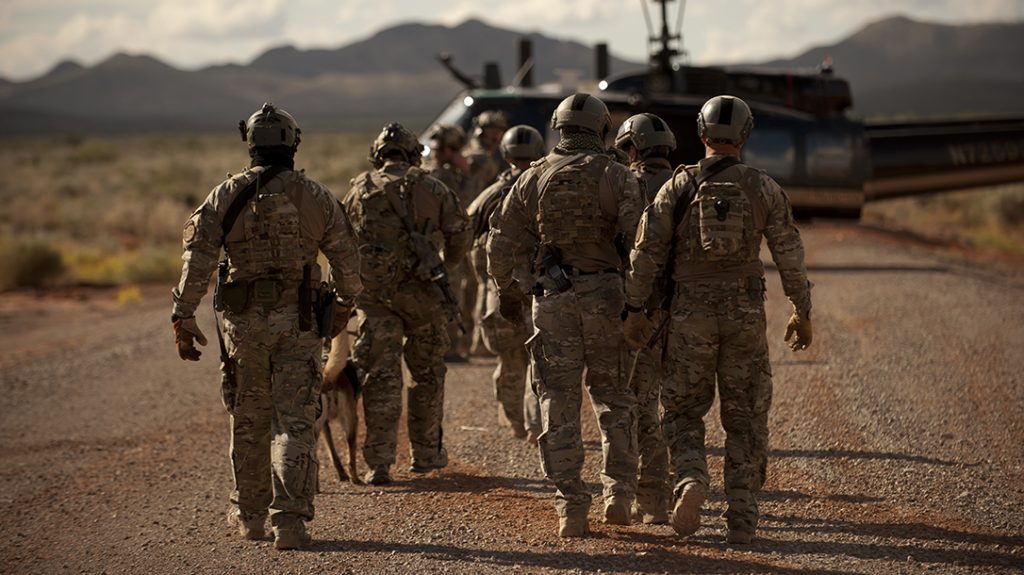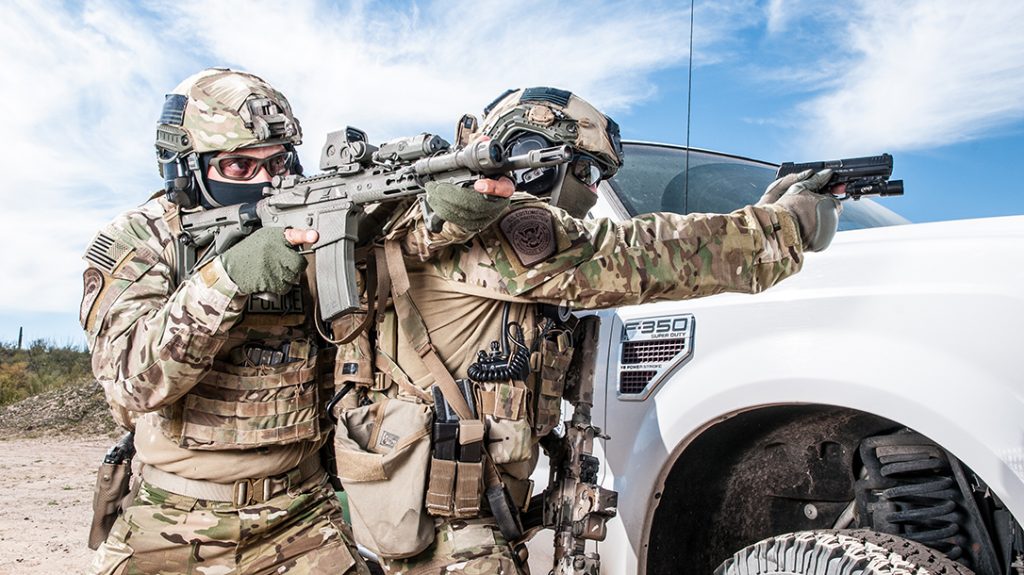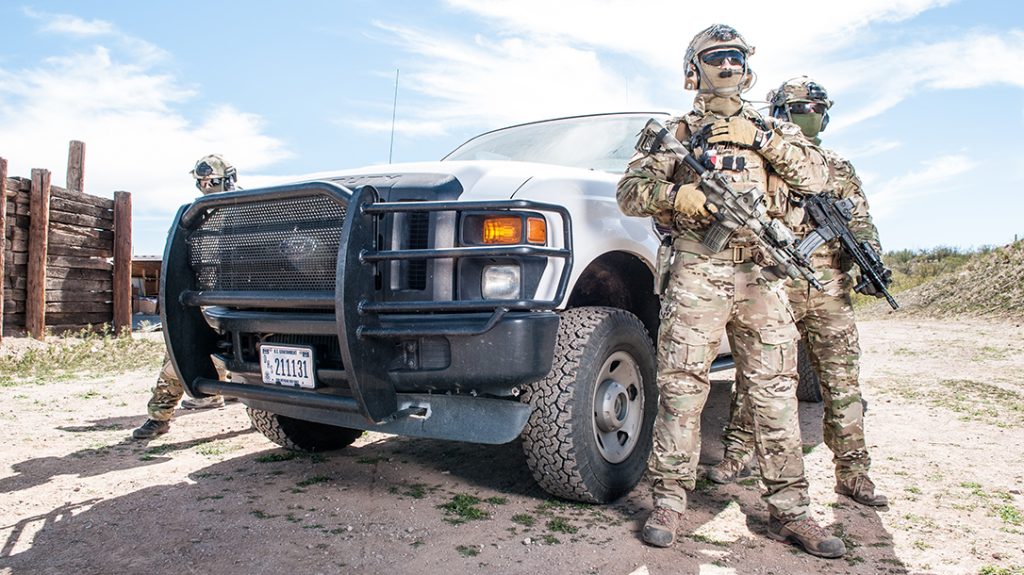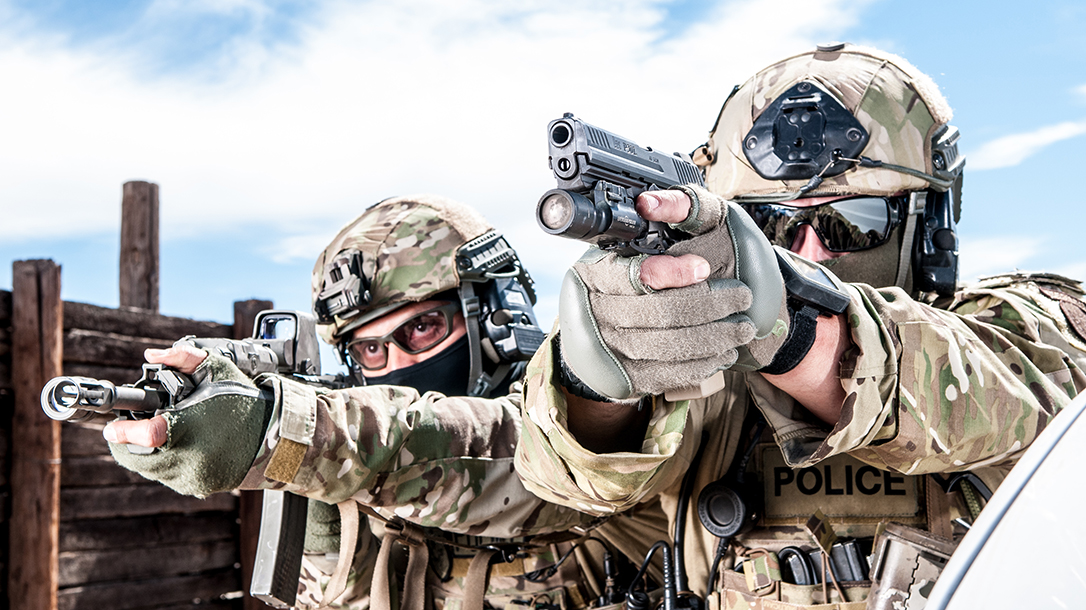In June 2015 two convicted killers, Richard Matt and David Sweet, escaped from the maximum-security Clinton Correctional Facility in rural upstate New York. It kicked off a massive search by local, state and federal law enforcement agencies. Frustrated by the thick wooded and mountainous landscape, New York State Police called to mobilize BORTAC, the U.S. Border Patrol’s enigmatic tactical special operations team. Its officers maintain expertise in the agency’s traditional skill set of tracking humans, also known as sign cutting.
BORTAC: Elite Fighting Force
BORTAC is effectively U.S. law enforcement’s quick-reaction force that enjoys a certain degree of anonymity—an aura they prefer to maintain. They’re ready at a moment’s notice from their inconspicuous headquarters at Fort Bliss in El Paso, Texas, to respond to emergencies, not only around the U.S. but the world. The team’s main focus is surveillance and interdiction of high-threat areas on the border for narcotics traffickers, as well as issuance of high-risk arrest and search warrants. But their mission does not end there. BORTAC works diplomatic security, searches for wanted suspects and escaped inmates, and provides site security during civil unrest, which most recently included Portland, Oregon, and Washington, D.C. Consummate special operators, they enter and exit an area of operation quietly and without fanfare. Deployments are not unlike those in the military, which are mission based and can last weeks or months.
Top Tier Creds
The team’s mission looks strikingly similar to that of the Army’s Green Berets. They perform as expert operators, they also intricately train international law enforcement agencies in narcotic interdiction, security and border security. Their international legacy includes deployments to nearly 30 countries. Locations include Afghanistan, Egypt, Guatemala, Honduras, Iraq and Mexico, to name a few. Outside of the patches on their Army-style BDUs, one would be hard-pressed to distinguish them from any Department of Defense Tier 1 unit, which the teams frequently train with.
Advertisement — Continue Reading Below
“I would never have imagined I would have traveled to more countries with the Border Patrol than I did in the Marine Corps,” said Michael Newbern, special operation supervisor and Marine combat veteran.
BORTAC began in 1984 in response to rioting in the former Immigration and Naturalization legacy migrant facilities. BORTAC falls under the U.S. Border Patrol’s Special Operations Group along with its sister organization, BORSTAR, which is the agency’s elite search-and-rescue team. In the ensuing decades, BORTAC’s mission quickly yet surreptitiously expanded. That is until 2000 in the highly publicized rescue of Elian Gonzalez.
Gonzalez was age five when he and his mother fled Cuba on a raft for Florida with 13 other refugees. Elian was only one of three who survived the treacherous journey. After his rescue, he stayed with relatives in Miami. His biological father, Juan Miguel, fought for his son’s return to Cuba. Legally, Elian could have stayed in the United States. After a six-month long contentious battle, the Clinton administration decided the youngster needed to return to Cuba. Following orders, BORTAC entered the house and retrieved the child. The resulting iconic photo showed a team member reaching for the child while holding an MP-5. Officials repatriated the child with his father.
Advertisement — Continue Reading Below
Tactics At A Glance
It might appear on the surface this high-octane unit contradicts the tenets of how a law enforcement unit should operate. In fact, it is the very discipline and training the team undergoes that makes it highly effective in accomplishing missions within the framework of the law and suspect’s civil rights.
“Our use of force policy is rock solid,” said Marco Cervantes, BORTAC patrol agent in charge. “Even with all of the recent civilian unrest, all reviews of our uses of force were within legal authority and guidelines.”

Advertisement — Continue Reading Below
Christopher Voss, special operations supervisor and veteran of three combat deployments with the 75th Ranger Regiment, expanded on that premise.
“Our tactics are rooted in fundamental military doctrine. However, in BORTAC we put our law enforcement spin on them while performing these tactics in our particular law enforcement environments,” Voss said. “What the military calls an ambush, we call an interdiction. The military identifies the ‘kill zone,’ we identify the ‘interdiction location.’ The military will traditionally initiate the ambush with the most casualty producing weapon(s), BORTAC uses ‘battlefield deception’ in order to determine the means, opportunity and intent of our adversaries prior to closing the distance and effecting an arrest.”
Voss said the major difference is that in some military missions, the intent is to inflict maximum casualties, like in the ambush example. Conversely, when BORTAC conducts a direct-action mission, the arrest is always the primary intent with deadly force used only when a suspect has the means, opportunity and intent to inflict serious bodily harm or death.
Advertisement — Continue Reading Below
“We do not have different rules of engagement based on our different operations,” Voss said. “We simply apply our agency’s use of force directives to all law enforcement situations.”
Spear Sharpening
Training is the core value of the team. Because of their unique mission set they enjoy relative autonomy from bureaucratic intrusion. The training resources they have couldn’t be better. Nestled in a remote corner of the Fort Bliss reservation is the team’s Spartan training facility, replete with an 80-foot tower for rappelling and high-angle insertions; a shorter tower with the cabin of a helicopter to replicate fast roping into an operation; multiple firing ranges of varying length; and multiple shoot houses where the essentials of structure clearing and close-quarter combat skills are honed. The desert environment with adjacent mountains makes the facility ideal for squad tactics and suspect search scenarios.
Applying for the team has to begin with personal soul searching and a sincere inventory of physical and psychological capabilities. Motivation is one thing, but the demands of the team involve much more, as with any special operations unit, such as combining physical ability with intelligence, adaptability, flexibility and the ability to work well within a team. Many apply, but few earn selection. When Voss completed his stint in the military, he felt it only natural he turn to Border Patrol with his eyes on BORTAC.
Advertisement — Continue Reading Below

Newbern said in some respects BORTAC is reminiscent of his time with the Corps. But at times it can be even tougher. He compared the qualifying course to a combination of the early stages of Force Recon and Ranger courses.
BORTAC mirrors military special operation units where the average age of operators is early to mid-thirties. A third of the team is former military. The remainder comes from diverse backgrounds that include civilian law enforcement and corrections.
Advertisement — Continue Reading Below
Making The Cut
To become a member of BORTAC, interested Border Patrol Agents with a minimum of two years continuous service are required to submit a memorandum of interest through their chain of command.
Assessment Phase
Agents must complete initial screening requirements, which consist of a physical aptitude test (PAT), score a 90 percent or higher with their issued handgun and pass a structured oral interview during initial screening.
The BORTAC PAT is a max effort pass/fail assessment that consist of multiple events:
Advertisement — Continue Reading Below
- 300-meter sprint in 54 seconds or less
- Minimum of 42 sit-ups in one minute or less
- Minimum of 40 push-ups (no time limit)
- One .5-mile run in 11 minutes or less
- Minimum of eight pull-ups (no time limit)
Selection Phase
After fulfilling the initial screening phase, agents must successfully complete the BORTAC Selection and Certification courses. The combined duration of the selection and certification courses generally ranges from eight to 10 weeks.
The Selection Phase Qualifications include:
BORTAC PAT
- Swim qualification (100 meter swim, treading water in uniform and boots, and drown-proofing)
- Qualify with 90 percent or higher with issued sidearm
- Qualify with 90 percent or higher with M-4 carbine
- Complete 6-mile road march with mission essential equipment in 1 hour and 45 minutes or less
Upon completion of the courses, agents will have the opportunity to join their respective Sector BORTAC team. Approximately 225 active BORTAC team members spread throughout the 20 sectors on the northern and southern borders. BORTAC agents also are eligible to apply for vacancies with the national team at Special Operations Group (SOG) HQ in El Paso. Personnel earn selection based on merit and SOG BORTAC specialty certification needs at the time of the vacancy announcement. Specialty program areas that require additional certifications include Breachers, Patrol K9 Handlers and Precision Marksman Observers.
Advertisement — Continue Reading Below

“There are requirements to requalify; however, operators must maintain a minimal number of required training hours as indicated in the BORTAC Mission Essential Task List (METL),” Cervantes said. “These minimal requirements must be maintained on a yearly basis. Firearms qualifications must be conducted on a quarterly basis at the 90 percentile standards. However, to maintain proficiency in all fields, training is conducted periodically (quarterly, monthly or weekly depending on the level of proficiency).”
Back To New York
Here’s how the finale of the operation to find the escaped inmates in the woods of upper New York played out. Voss and his team inserted into the area by a Customs and Border Protection Air and Marine Operations UH-60 Blackhawk helicopter on June 26, 2015, after reports of shots fired in the area.
After hitting the ground, Voss and his five-man fire team advanced into the woods in a staggered line formation. At first it appeared the search was going nowhere when a New York State Trooper said he heard coughing in the wood line. The team fanned out. A short time later an agent saw someone laying prone beside a log near a ridge and ordered him to put his hands up.
Voss broke right and saw Matt raise his head. The escaped killer then made the fatal mistake of pointing his shotgun at Voss.
“At that point, I engaged the individual,” Voss would tell NBC News in a rare interview. “It’s nothing we ever set out to do, it’s never good when there’s a loss of life, but at the end of the day, ultimately, Richard Matt gave me no other option by pointing his shotgun at me.”
As quietly as they entered the mission is how they returned back to El Paso, waiting and preparing to respond to the next call-out at a moment’s notice.
Agent Brian Terry
In BORTAC’s 36-year history, the team has lost only one operator to hostile action in the line of duty. That involved a tragedy compounded by the circumstances surrounding Tucson Sector Agent Brian Terry’s murder. On December 15, 2010, Terry, 40, and his team were posted near Rio Rico, Arizona, to surveil the area for “rip crews.” These bandits, primarily from Mexico, would rob and assault migrants crossing the border.
Around 11p.m., Terry’s team made contact with five men who opened fire on them with AK-47s. Terry took fire in the pelvis and would die en route to the hospital. The single 7.62-caliber round severed his spinal cord and main artery to the heart. Compounding the tragedy, two of the weapons used in the attack proved connected to the botched Fast and Furious program, in which Barack Obama’s ATF intentionally let the guns fall into the hands of Mexican criminals. Officials later arrested all five of the suspects. For more, please visit honorbrianterry.com.
This article is from the March 2021 issue of Tactical Life magazine. Grab your copy at OutdoorGroupStore.com.























